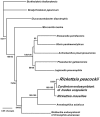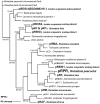Genome sequence of the endosymbiont Rickettsia peacockii and comparison with virulent Rickettsia rickettsii: identification of virulence factors
- PMID: 20027221
- PMCID: PMC2791219
- DOI: 10.1371/journal.pone.0008361
Genome sequence of the endosymbiont Rickettsia peacockii and comparison with virulent Rickettsia rickettsii: identification of virulence factors
Abstract
Rickettsia peacockii, also known as the East Side Agent, is a non-pathogenic obligate intracellular bacterium found as an endosymbiont in Dermacentor andersoni ticks in the western USA and Canada. Its presence in ticks is correlated with reduced prevalence of Rickettsia rickettsii, the agent of Rocky Mountain Spotted Fever. It has been proposed that a virulent SFG rickettsia underwent changes to become the East Side Agent. We determined the genome sequence of R. peacockii and provide a comparison to a closely related virulent R. rickettsii. The presence of 42 chromosomal copies of the ISRpe1 transposon in the genome of R. peacockii is associated with a lack of synteny with the genome of R. rickettsii and numerous deletions via recombination between transposon copies. The plasmid contains a number of genes from distantly related organisms, such as part of the glycosylation island of Pseudomonas aeruginosa. Genes deleted or mutated in R. peacockii which may relate to loss of virulence include those coding for an ankyrin repeat containing protein, DsbA, RickA, protease II, OmpA, ScaI, and a putative phosphoethanolamine transferase. The gene coding for the ankyrin repeat containing protein is especially implicated as it is mutated in R. rickettsii strain Iowa, which has attenuated virulence. Presence of numerous copies of the ISRpe1 transposon, likely acquired by lateral transfer from a Cardinium species, are associated with extensive genomic reorganization and deletions. The deletion and mutation of genes possibly involved in loss of virulence have been identified by this genomic comparison. It also illustrates that the introduction of a transposon into the genome can have varied effects; either correlating with an increase in pathogenicity as in Francisella tularensis or a loss of pathogenicity as in R. peacockii and the recombination enabled by multiple transposon copies can cause significant deletions in some genomes while not in others.
Conflict of interest statement
Figures



Similar articles
-
Sequence and expression analysis of the ompA gene of Rickettsia peacockii, an endosymbiont of the Rocky Mountain wood tick, Dermacentor andersoni.Appl Environ Microbiol. 2004 Nov;70(11):6628-36. doi: 10.1128/AEM.70.11.6628-6636.2004. Appl Environ Microbiol. 2004. PMID: 15528527 Free PMC article.
-
Genomic comparison of virulent Rickettsia rickettsii Sheila Smith and avirulent Rickettsia rickettsii Iowa.Infect Immun. 2008 Feb;76(2):542-50. doi: 10.1128/IAI.00952-07. Epub 2007 Nov 19. Infect Immun. 2008. PMID: 18025092 Free PMC article.
-
Comparative genome sequencing of Rickettsia rickettsii strains that differ in virulence.Infect Immun. 2015 Apr;83(4):1568-76. doi: 10.1128/IAI.03140-14. Epub 2015 Feb 2. Infect Immun. 2015. PMID: 25644009 Free PMC article.
-
Plasmids and rickettsial evolution: insight from Rickettsia felis.PLoS One. 2007 Mar 7;2(3):e266. doi: 10.1371/journal.pone.0000266. PLoS One. 2007. PMID: 17342200 Free PMC article. Review.
-
Paradoxical evolution of rickettsial genomes.Ticks Tick Borne Dis. 2019 Feb;10(2):462-469. doi: 10.1016/j.ttbdis.2018.11.007. Epub 2018 Nov 12. Ticks Tick Borne Dis. 2019. PMID: 30448253 Review.
Cited by
-
Tropism and pathogenicity of rickettsiae.Front Microbiol. 2012 Jun 25;3:230. doi: 10.3389/fmicb.2012.00230. eCollection 2012. Front Microbiol. 2012. PMID: 22737150 Free PMC article.
-
Phylogenetic, genomic, and biogeographic characterization of a novel and ubiquitous marine invertebrate-associated Rickettsiales parasite, Candidatus Aquarickettsia rohweri, gen. nov., sp. nov.ISME J. 2019 Dec;13(12):2938-2953. doi: 10.1038/s41396-019-0482-0. Epub 2019 Aug 5. ISME J. 2019. PMID: 31384012 Free PMC article.
-
Genomic evolution and adaptation of arthropod-associated Rickettsia.Sci Rep. 2022 Mar 9;12(1):3807. doi: 10.1038/s41598-022-07725-z. Sci Rep. 2022. PMID: 35264613 Free PMC article.
-
Metagenome diversity illuminates the origins of pathogen effectors.mBio. 2024 May 8;15(5):e0075923. doi: 10.1128/mbio.00759-23. Epub 2024 Apr 2. mBio. 2024. PMID: 38564675 Free PMC article.
-
Draft genome sequence of the male-killing Wolbachia strain wBol1 reveals recent horizontal gene transfers from diverse sources.BMC Genomics. 2013 Jan 16;14:20. doi: 10.1186/1471-2164-14-20. BMC Genomics. 2013. PMID: 23324387 Free PMC article.
References
-
- Niebylski ML, Schrumpf ME, Burgdorfer W, Fischer ER, Gage KL, et al. Rickettsia peacockii sp. nov., a new species infecting wood ticks, Dermacentor andersoni, in western Montana. Int J Syst Bacteriol. 1997;47:446–452. - PubMed
-
- Burgdorfer W, Hayes SF, Mavros AJ. Nonpathogenic rickettsiae in Dermacentor andersoni: a limiting factor for the distribution of Rickettsia rickettsii. In: Burgdorfer W, Anacker RL, editors. Rickettsiae and rickettsial diseases. New York, N.Y.: Academic Press; 1981. pp. 585–594.
-
- Philip RN, Casper EA. Serotypes of spotted fever group rickettsiae isolated from Dermacentor andersoni (Stiles) ticks in western Montana. Am J Trop Med Hyg. 1981;30:230–238. - PubMed
Publication types
MeSH terms
Substances
Grants and funding
LinkOut - more resources
Full Text Sources
Molecular Biology Databases

